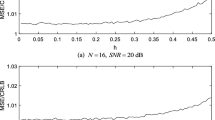Abstract
Time diversity is achieved in direct sequence spread spectrum by receiving different faded delayed copies of the transmitted symbols from different uncorrelated channel paths when the transmission signal bandwidth is greater than the coherence bandwidth of the channel. In this paper, a new time diversity scheme is proposed for spread spectrum systems. It is called code-time diversity. In this new scheme, N spreading codes are used to transmit one data symbol over N successive symbols interval. The diversity order in the proposed scheme equals to the number of the used spreading codes N multiplied by the number of the uncorrelated paths of the channel L. The paper represents the transmitted signal model. Two demodulators structures will be proposed based on the received signal models from Rayleigh flat and frequency selective fading channels. Probability of error in the proposed diversity scheme is also calculated for the same two fading channels. Finally, simulation results are represented and compared with that of maximal ration combiner and multiple-input and multiple-output systems.











Similar content being viewed by others
References
Gacanin, H., Takaoka, S., & Adachi, F. (2007). BER performance of OFDM combined with TDM using frequency-domain equalization. IEEE Journal of Communications and Networks, 9(1), 34–42.
Hua, K., Nguyen, L., & Jang, W. M. (2006). Performance of coded frequency-hopped OFDM systems in frequency selective channels. In: 8th International conference on signal processing, Vol. 3.
Arijon, I. M., & Farrell, P. G. (1996). Performance of an OFDM system in frequency selective channels using Reed–Solomon coding schemes. IEE Colloquium on Multipath Countermeasures, 6/1–6/7.
Liu, Y., Tan, Z., Wang, H., & Kwak, K. S. (2011). Joint estimation of channel impulse response and carrier frequency offset for OFDM systems. IEEE Transactions on Vehicular Technology, 60(9), 4645–4650.
Cui, T., & Tellambura, C. (2007). Joint frequency offset and channel estimation for OFDM systems using pilot symbols and virtual carriers. IEEE Transactions on Wireless Communications, 6(4), 1193–1202.
Shi, Q., Guan, Y. L., & Gong, Y. (2010). Fractionally spaced frequency-domain MMSE receiver for OFDM systems. IEEE Transactions on Vehicular Technology, 59(9), 4400–4407.
Ahmed, M. Sh. et al. (2011). OFDM based on low complexity transform to increase multipath resilience and reduce PAPR. IEEE Transactions on Signal Processing, 59(12), 5994–6007.
Eom, S.-S., Nam, H., & Ko, Y.-C. (2012). Low-complexity PAPR reduction scheme without side information for OFDM systems. IEEE Transactions on Signal Processing, 60(7), 3657–3669.
Krenz, R., & Wesołowski, K. (1997). Comparative study of space-diversity techniques for MLSE receivers in mobile radio. IEEE Transactions on Vehicular Technology, 46(3), 653–663.
Tall, A., Rezki, Z., & Alouini, M.-S. (2012). MIMO channel capacity with full CSI at low SNR. IEEE Wireless Communications Letters, 1(5), 488–491.
Matthaiou, M., Chatzidiamantis, N. D., Karagiannidis, G. K., & Nossek, J. A. (2010). On the capacity of generalized- fading MIMO channels. IEEE Transactions on Signal Processing, 58(11), 5939–5944.
Gozálvez, D., Gómez-Barquero, D., Vargas, D., & Cardona, N. (2011). Time diversity in mobile DVB-T2 systems. IEEE Transactions on Broadcasting, 57(3), 617–628.
Wei, L.-F. (1993). Coded M-DPSK with built-in time diversity for fading channels. IEEE Transactions on Information Theory, 39(6), 1820–1839.
Wong, W. C. et al. (1983). Time diversity with adaptive error detection to combat Rayleigh fading in digital mobile radio. IEEE Transactions on Communications, COM-31(3), 378–387.
Song, B., Kim, N., & Park, H. (2012). A binary space-time code for MIMO systems. IEEE Transactions on Wireless Communications, 11(4), 1350–1357.
Chen, C.-H., & Chung, W.-H. (2012). Dual diversity space-time coding for multimedia broadcast/multicast service in MIMO systems. IEEE Transactions on Communications, 60(11), 3286–3297.
Molisch, A. F., Win, M. Z., & Winters, J. H. (2002). Space-time-frequency (STF) coding for MIMO-OFDM systems. IEEE Communications Letters, 6(9), 370–372.
Shin, O.-S,. Chan, A. M., Kung, H. T., & Tarokh, V. (2007). Design of an OFDM cooperative space-time diversity system. IEEE Transactions on Vehicular Technology, 56(4), 2203–2215.
Li, S., Huang, D., Letaief, K. B., & Zhou, Z. (2007). Pre-DFT processing for MIMO-OFDM systems with space-time-frequency coding. IEEE Transactions on Wireless Communications, 6(11), 4176–4182.
Shi, L., Zhang, W., & Xia, X.-G. (2013). Space-frequency codes for MIMO-OFDM systems with partial interference cancellation group decoding. IEEE Transactions on Communications, 61(8), 3270–3280.
Proakis, J. G. (2001). Digital communications. New York: McGraw-Hill Inc.
Rappaport, T. S. (1996). Wireless communications principles and practice (pp. 169–177). New York, Prentice Hall: IEEE Press.
Alamouti, S. M. (1998). A simple transmit diversity technique for wireless communications. IEEE Journal on Select Areas in Communications, 16(8), 1451–1458.
Al-Hussaini, E. K., & Al-Bassiouni, A. A. M. (1985). Performance of MRC diversity systems for the detection of signals with nakagami fading. IEEE Transaction on Communication, COM-33(12), 1315–1319.
Gradshteyn, I. S., & Ryzhik, I. M. (2007). Tables of integrals, series, and products (7th ed.). ELSEVIER: Academic Press.
Chiani, M., Dardari, D., & Simon, M. K. (2003). New exponential bounds and approximations for the computation of error probability in fading channels. IEEE Transactions on Wireless Communications, 4(2), 840–845.
Author information
Authors and Affiliations
Corresponding author
Appendices
Appendix 1
The generalized hypergeometric function pFq has a series expansion as shown in the following equation.
This mathematical function is suitable for both symbolic and numerical manipulation. (a) k is the Pochhammer symbol defined as:
Appendix 2
Starting from Eq. (38)
From [26] the erfc() can be approximated to:
From 3.462 in [25]
Referring to equation (63)
By substituting equation (64) in (63), the integration can be solved and the final value of the average probability of error can be represented as:
Rights and permissions
About this article
Cite this article
Hassan, A.Y. Code-Time Diversity for Direct Sequence Spread Spectrum Systems. Wireless Pers Commun 84, 695–718 (2015). https://doi.org/10.1007/s11277-015-2656-z
Published:
Issue Date:
DOI: https://doi.org/10.1007/s11277-015-2656-z




